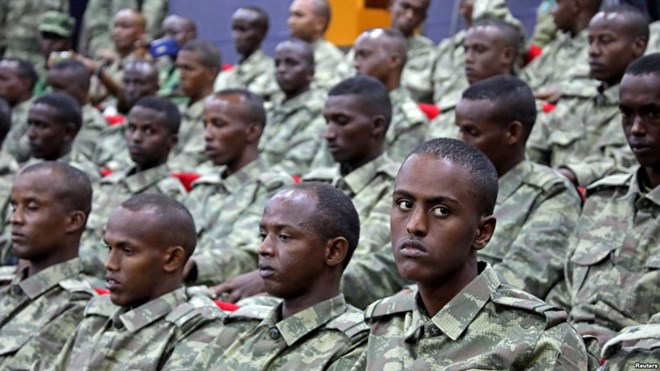
Wednesday December 20, 2017

Since September 2017, al-Shabab militants have overrun four Somali government military bases, killing more than 60 soldiers and seizing large quantities of weapons.
Now, a military assessment by the Somali government found some of the troops manning these bases are completely unarmed.
The "Operational Readiness Assessment" conducted by the government found that approximately 30 percent of the soldiers in the bases do not have weapons. The evaluators said some units also lack medium and heavy weaponry, and some are "undermanned."
On Tuesday, Somali Defense Minister Mohamed Mursal Sheikh Abdirahman acknowledged the army's shortcomings.
"There are some who are not armed. We are working to complete their equipment but a majority of them have weapons," he said in an exclusive interview with VOA's Somali service.
He also admitted "gaps" in the number of soldiers in military bases.
"When we were conducting this assessment we did not announce and say people have to report for this assessment, we only went there and assessed those ready in their bases, their training and equipment," he said. "There are gaps, there are brigades which are undermanned."
Abdirahman said the number of soldiers on the payroll of the Somali National Army is 26,000 but added that number includes retired and older soldiers, the disabled and orphans.
Reliable military sources told VOA that the actual number of soldiers on duty is far lower, possibly fewer than 10,000.
The assessment commissioned by Prime Minister Hassan Ali Khaire was conducted between August and September and was submitted to government leaders in November.
Al-Shabab gains
Al-Shabab overran government bases in the towns of Bulogudud, Beled Hawo, El-Wak and Barire in September. Abdirahman said government soldiers didn't have the artillery, heavy machine guns and shoulder-fired missiles to push back Shabab fighters as they stormed the bases.
He said infantry units need artillery, some mounted on trucks, others pulled by trucks and shoulder missiles to enable soldiers to fight from a long distance before the enemy comes into close proximity.
"An army needs to be able to defend itself from 4-5 kilometers away from the base," he said. "We don't have that type of weapons of artillery and missiles. Likewise, we don't have helicopters that can provide air support that can fire missiles at enemy positions to prevent attack and destroy threats at its place."
Abdirahman blamed the United Nations arms embargo on Somalia for the lack of these weapons, saying the embargo is tying the hands of Somali soldiers.
"[T]he international community must allow Somalia to have this weaponry," he said. "They don't have to lift it in one day but gradually; there has to be a mechanism for Somalia to acquire and buy these weapons and to arm its soldiers."
The assessment also found the SNA constrained by a lack of communication, vehicles and shelter, with some soldiers living in bush perimeters with no sentry positions.
Aid suspension
Last week, the United States said it is suspending aid for much of Somalia's armed forces over corruption concerns. A State Department official said the "pause" in aid is being made "to ensure that U.S. assistance is being used effectively and for its intended purpose."
The current Somali government, which blame previous administrations, said the fact it conducted an assessment shows its commitment to improving accountability as well as conditions for the soldiers.
The government has announced plans to build a force of 22,000 soldiers that can take over security responsibilities from the African Union Mission in Somalia, AMISOM, which has begun to draw down its troops.